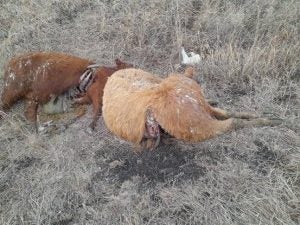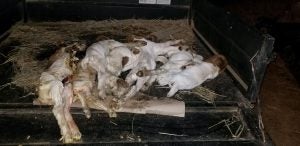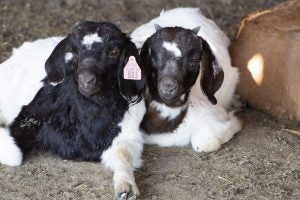Brenda Jordan and Mike Winter ordered feed like they do numerous times per year for their small, family-owned Kansas farm, Triple Heartbreak Acres. But, this time, Jordan said a critical feed mixing error from the mill has left their operation scrambling to save what’s left of their livestock herd.
Three days after the feed truck showed up early this month, the family found the first dead, weaned calf, which was approximately 550 pounds.
Now, two weeks into the ordeal, the death toll continues to rise: 10 head of adult does, 40 kids, the family’s registered heifers, and their kid’s show calves. Twenty years of genetics at this Riley, Kansas, farm is gone in mere weeks.

At the time that all this began, Jordan and Winter were at a livestock show in Denver. It took a while for the mill to send batch sheets for the delivered feed, but everything looked OK on paper when they were received. The batch sheets didn’t account for the dead livestock, though. Veterinarians ruled out pneumonia as well as coccidiosis.
The culprit? Jordan said it appears that a worker at the mill had mixed in straight Type A Rumensin instead of the premix. When she received the feed analysis from Kansas State, the analysis measured the dosage of monensin at 3500 parts per million (ppm) when the allowed rate is 0 to 20 ppm — that’s more than 174 times the allowed range.
The family says that they’ve used the same feed company and mix for 20 years. But sadly, this one error has devastated the genetics in their registered red angus and Boer goat herds.
“I’m originally from a farm, and so is my husband,” Jordan said. “We’ve raised our kids on the farm, taught them to use their stock for shows. Now, we have kids questioning whether they want to continue in the livestock because they’re losing generations of genetics over something out of our control.”
An email from AGDAILY to the feed mill seeking comment hasn’t been answered.

It’s not just the death count placing a toll on the family; the remaining 90 head of brood does were thrown into pregnancy toxemia. The farm has lost nine of 11 weaned calves that consisted of show steers, heifers, and replacement heifers. The remaining cattle — one bull and seven heifers the family was breeding — may yet abort the calves and continue to have breeding issues.
“This nightmare is not only killing them, but the ones that aren’t aborting early, the kids don’t have milk. They may or may not come back into milk,” Jordan said. “Their bags are gone, their bodies are sucking protein up wherever they can. We are looking at long-term heart damage, does that likely won’t cycle this next time, or who won’t breed up when they cycle? We’re going to be managing reproductive issues for a while on animals that live.”
Jordan said that part of the problem with treating the remaining livestock is that there’s not as much information about monensin toxicity in goats.
Rumensin is the brand name of Elanco’s monensin product, a medicated feed additive that is often included in goat feeds to help prevent coccidiosis. An Elanco veterinarian said Rumensin is typically a safe, effective feed additive when used appropriately, but that this large of an dose will lead to toxicity. Jordan is working closely with another Elanco vet on the situation.
Jordan also reported that the family has had to hire farm help to assist in bottle-feeding babies. They’re having to make calls on whether to perform cesarean sections and euthanasia on does that are suffering to try to save their kids. And, they’re having to search for neighboring dairy goats to help supplement essential colostrum in surviving newborns.

“In this herd, I lose some every year. I don’t lose does, though. I lose babies. Now, we’re having babies born 3 to 4 weeks premature, and some without hair,” Jordan said. “It’s heartbreaking to watch the does struggle to get their kids out. It’s heartbreaking to watch all of the hard work my kids have put into this herd go to waste.”
Within an hour of receiving a call from the feed nutritionist, Jordan said that the CEO of the feed company, whose mill is located in Clay Center, Kansas, called and accepted full responsibility.
Jordan said the feed mill’s insurance company is expected cover some of the loss, but accounting for the genetic loss, vet bills, and finding new show calves for the family before their county’s ownership deadline next month, things continue to be challenging.
A family friend, Susan Shipman has started a small fundraiser to assist the family in purchasing new show calves, and to assist with vet bills, medication, and supplies.
This is a developing story and will be updated as more details and comments become available.
Heidi Crnkovic, is the Associate Editor for AGDAILY. She is a New Mexico native with deep-seated roots in the Southwest and a passion for all things agriculture.



